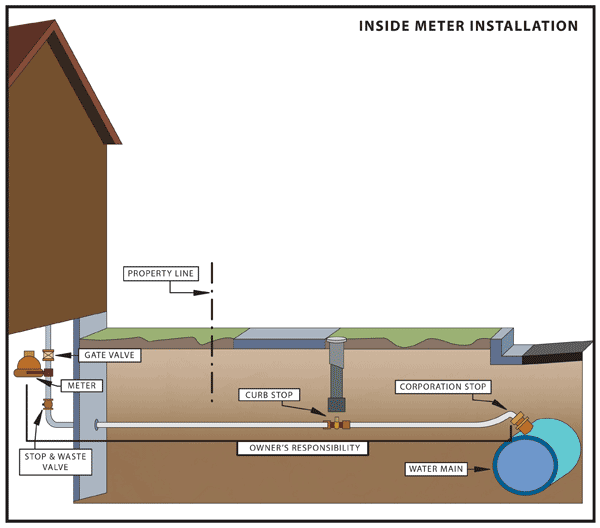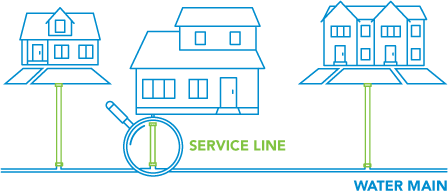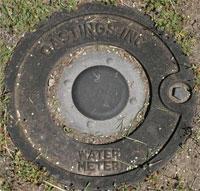Denver Water is responsible for maintaining and replacing water mains throughout its service area, while property owners are responsible for the service lines and meter pits at their service address.
Water damage can cost you
Water damage may or may not be covered separately from a typical homeowner’s insurance policy. To verify whether water damage is covered in your policy, contact your insurance agent. Denver Water is not responsible for water damage caused by a property’s service line or internal plumbing.
Service lines
Service lines include all pipe and fittings up to and including the stop and waste valve in a building with an outside meter setting, and up to and including the valve at the downstream side of the meter for an inside meter setting.
The dividing point between Denver Water-owned mains or distributor-owned mains and service lines that are the responsibility of the property owner is located where the property taps into the main, or the discharge side of the valve closest to the Denver Water-owned or distributor-owned main. At this dividing point, water leaves the public system and enters privately-owned facilities to serve individual premises. The service line is owned by and installed at the expense of the property owner.
Denver Water cares about public health and will replace any customer-owned lead service line with a copper water line, at no direct charge to the customer, when discovered during the project. Customers who have lead service lines that are not encountered during pipe replacement work will be enrolled in the Lead Reduction Program. As part of the program, Denver Water will replace customer-owned lead service lines with copper service lines at no direct charge to the customer. Denver Water estimates there are 64,000-84,000 properties that may have lead service lines in its service area. It will take 15 years to replace all of them. Customers enrolled in the Lead Reduction Program will be notified by mail in spring 2020.
Customers may wish to replace their lead service line on their own, or during remodel or renovation of a home. Please review our Redevelopment Policy before replacing your lead service line.
Property owners who want to replace their lead service line at their own expense may be eligible for a partial reimbursement of their total cost. To be considered, fill out the Lead Service Line Replacement Reimbursement Pre-Approval Form.
Below is an example of an outside and an inside meter setting. Refer to Denver Water's Engineering Standards, standard drawings 53, 54 and 55 for specific layout dimensions.


Meter pits
In addition to the service line, the property owner also is responsible for the meters read by Denver Water and the meter pits in which they are located. Meter pits are manholes or vaults that house meters and protect them from the elements.
Meter pits are usually located in the front yard, and are sometimes installed in the sidewalk. The pit is a round metal plate about 12 inches in diameter, and usually says “Water Meter” on it. Most meter pits are also fitted with an Automatic Meter Reading device (an ERT) fitted through the lid, although some AMR devices are installed underneath the lid, and some are mounted on the sides of buildings. Meter pits are not designed to support the weight of a vehicle. Meter pits installed in driveways or parking areas often experience damage that can be very expensive to repair.
The meter and meter setting and the AMR device also belong to the property owner. Denver Water will maintain and repair these devices when they fail due to normal wear and tear, but it is the property owner’s responsibility to protect them from damage from lawn mowers, traffic, freezing and vandalism.
Meter pits must comply with specifications in Denver Water's Engineering Standards, including requirements dealing with proper materials, frost and freeze protection and the pit being set to and maintained to 3/4 inch above the finished grade of the ground or surrounding property, or flush with the pavement if installed in a sidewalk or driveway.
Never place any objects on the meter pit lid. Do not plant bushes or other plants within 2 feet around the meter pit lid (grass is OK). Do not install walls, fences, mailboxes or other obstructions within 5 feet of the meter. Never place a fence or a wall between the water meter and the street.
Meters that are inside of a building must be kept accessible by the owner or resident. Do not place any items within 5 feet of an indoor meter. If you wish to enclose the meter in a finished space, leave an access panel or door 36 inches wide that extends from the floor to the gate valve above the meter.
Stop box and valve
Most water services have a stop box on the street side of the meter pit (or near the front property line for inside meters). This top of the box is usually a 3-inch to 4-inch diameter disk, with a tube extending downward to a valve that is about 4 ½ to 6 feet deep. This valve helps the property owner and Denver Water control the water flow if there is a leak in the service line or plumbing on the property. To serve its purpose, the stop box must be level with the ground around it and accessible to Denver Water crews.
There must be at least 2 to 5 feet of space around the stop box free of shrubbery, walls, or other obstructions that would interfere with turning the valve key. Denver Water will replace a broken stop box cover when it is reported or observed, but all other maintenance of the stop box and valve is the responsibility of the property owner.
Over time, curb stop valves will wear out and become hard to operate, or the operating nut will break off. If Denver Water is unable to operate the valve, we will notify you that it needs to be replaced. You will need to have a licensed plumber do this work.
See Denver Water's Operating Rules for more information on property-owner responsibility for meters.


